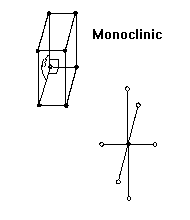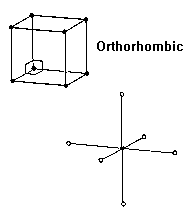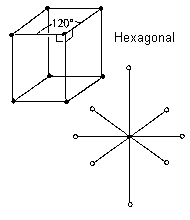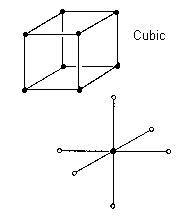|
|
||||||||||||||||
|
||||||||||||||||
|
||||||
|
| Chrystallography of Gems | |
|
| ||
|
| ||
|
|
Crystal molecules grow in three dimensional patterns or arrays. The atoms and molecules are locked in periodic or repeated arrays. These arrays can be categorized into six major crystal systems: hexagonal, isometric, monoclinic, orthorhombic, tetragonal, and triclinic. Trigonal has been called a seventh crystal system, but is actually only a subclass of the hexagonal crystal system and not a separate crystal system. Each
of these six major crystal systems is defined
in terms of crystal axes, which are imaginary
lines in space that intersect at a common
point. The lengths of these axes can be
described as equal or unequal to each other
and further described in terms of the angles
that the axes make with each other. These
crystal systems may affect the external
characteristics of a mineral such as crystal
shape (habit). |
||
|
|
Triclinic Minerals that crystallize in the triclinic crystal system include Axinite and Plagioclase. |
||
|
|
Monoclinic Minerals that crystallize in the monoclinic crystal system include Pyroxene, Amphibole, Orthoclase, Azurite and Malachite among many others. |
||
|
|
Orthorhombic Minerals that crystallize in the orthorhombic crystal system include Olivine (Peridot) and Barite. |
||
|
|
Tetragonal Minerals that crystallize in the tetragonal crystal system include Zircon and Cassiterite. |
||
|
|
Hexagonal Minerals that crystallize in the hexagonal division include apatite, beryl and high quartz. Minerals that crystallize in the rhombohedral division are Calcite, Dolomite, low Quartz and Tourmaline. |
||
|
|
Isometric
(Cubic) Minerals that crystallize in the isometric (cubic) crystal system include Cuprite, Diamond, Fluorite, Gahnite, Garnet, Hackmanite, Hauyne, Lazurite, Leucite, Rhodizite, Sphalerite, Spinel and Villiaumite. |
||
|
The six crystal systems describe the patterns of the molecules of crystals. Crystals can also be described by their external shape or "habit". Terms for crystal shapes include acicular (needlelike), bladed (flat with sharp edges), equant (roughly equal length sides), filiform (hairlike), prismatic (elongated), pyramidal (shaped like single or double pyramids) and tabular (flat with flat, perpendicular edges). The way minerals grow is greatly affected by the environment and temperature in which they form. Minerals deposited in sedimentary environments are usually earthy (masses of densley packed powder), stalactitic (shaped lick stalactites), oolitic or (masses of spherical grains) and sometimes massive (solid and chunky). Igneous minerals are usually crystalline (varioius crystal shapes), massive (solid and chunky) and sometimes cleavable (crystalline masses that can be cleaved). Below
is a more detailed list of crystal habits. |
|||
|
List of Crystal Habits (shapes) |
|||
|
Habit |
Description |
Example |
|
|
Acicular |
Needle-like, slender and/or tapered |
||
|
Amygdaloidal |
Almond-shaped |
Heulandite |
|
|
Anhedral |
Poorly formed, distorted |
||
|
Bladed |
Blade-like, slender and flattened |
||
|
Botryoidal or globular |
Grape-like, hemispherical masses |
||
|
Columnar |
Similar to fibrous: Long, slender prisms often with parallel growth |
||
|
Coxcomb |
Aggregated flaky or tabular crystals closely spaced. |
||
|
Dendritic or arborescent |
Tree-like, branching in one or more direction from central point |
||
|
Dodecahedral |
Dodecahedron, 12-sided |
||
|
Drusy or encrustation |
Aggregate of minute crystals coating a surface |
Uvarovite |
|
|
Enantiomorphic |
Mirror-image habit and optical characteristics; right- and left-handed crystals |
||
|
Equant, stout, stubby or blocky |
Squashed, pinnacoids dominant over prisms |
||
|
Euhedral |
Well-formed, undistorted |
||
|
Fibrous or columnar |
Extremely slender prisms |
||
|
Filiform or capillary |
Hair-like or thread-like, extremely fine |
||
|
Foliated or micaceous |
Layered structure, parting into thin sheets |
Mica |
|
|
Granular |
Aggregates of anhedral crystals in matrix |
||
|
Hemimorphic |
Doubly terminated crystal with two differently shaped ends. |
Hemimorphite |
|
|
Mamillary |
Breast-like: intersecting large rounded contours |
Malachite |
|
|
Massive or compact |
Shapeless, no distinctive external crystal shape |
Serpentine |
|
|
Nodular or tuberose |
Deposit of roughly spherical form with irregular protuberances |
Geodes |
|
|
Octahedral |
Octahedron, eight-sided (two pyramids base to base) |
Magnetite |
|
|
Plumose |
Fine, feather-like scales |
Mattramite |
|
|
Prismatic |
Elongate, prism-like: all crystal faces parallel to c-axis |
||
|
Pseudo-hexagonal |
Ostensibly hexagonal due to cyclic twinning |
||
|
Pseudomorphous |
Occurring in the shape of another mineral through pseudomorphous replacement |
Tiger's eye |
|
|
Radiating or divergent |
Radiating outward from a central point |
Pyrite suns |
|
|
Reniform or colloform |
Similar to mamillary: intersecting kidney-shaped masses |
||
|
Reticulated |
Acicular crystals forming net-like intergrowths |
||
|
Rosette |
Platy, radiating rose-like aggregate |
Gypsum |
|
|
Sphenoid |
Wedge-shaped |
||
|
Stalactitic |
Forming as stalactites or stalagmites; cylindrical or cone-shaped |
Rhodochrosite (Argentina) |
|
|
Stellate |
Star-like, radiating |
||
|
Striated/striations |
Surface growth lines parallel or perpendicular to c-axis |
||
|
Tabular or lamellar |
Flat, tablet-shaped, prominent pinnacoid |
||
|
Wheat sheaf |
Aggregates resembling hand-reaped wheat sheaves |
Zeolites |
|
|
|
|||





